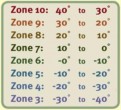






A hardiness zone is a geographically defined area in which certain types of plants can grow as defined by climatic conditions, including their ability to withstand the minimum temperatures of the zone. The hardiness zones are helpful in that extremes of winter cold are a major factor in determining whether a plant can grow in a particular location. However, there are problems with the system; most significantly, it does not consider summer heat levelThese are general guidelines that describe how poisonous certain houseplants are. It's possible for an allergic reaction to occur from contact with any houseplant, toxic or non-toxic. If there is ever a concern, call: Poison Control Center: ******1-800-222-1222****** Level #1: Houseplants with low toxicity, may be mildly irritating, especially the sap of the plant. Level#2: Houseplants with medium to severe toxicity. Eating parts of these houseplants may result in vomiting, diarrhea, stomach pains, skin irritations, and breathing difficulties. Level #3: These houseplants are very poisonous. When eaten, especially in large quantities, severe vomiting, diarrhea, stomach pains, skin irritations, and breathing difficulties can occur. Level #4: These houseplants are extremely poisonous. Eating parts of these houseplants can be be life threatening. Every plant listed in our Popular HousePlant guide has a section explaining whether or not it is poisonous and, if so, how poisonous. Amaryllis, alocasia, dieffenbachias, crotons, ivies, azaleas, lilies, and philodendrons are just a few of the highly poisonous plants we use in our homes and offices all of the time. If you don't know whether your houseplant is poisonous, go to Ask Judy on the HousePlant411.com website, send her a picture of your plant, and she'll let you know if the houseplant should be kept away from small children and pets. See colorful pictures and get more information about poisonous houseplants in Don’t Feed Me To Your Cat! A Guide to Poisonous Houseplants s. So places that may have the same minimum winter temperatures, but very different summer temperatures, are still placed in the same hardiness zone. If a plant is said to be able to grow in zone 10 it means that it can handle temperatures down to 30-40 degrees Fahrenheit (-1.1 to 4.4 C)-40 °C. To find your Hardiness Zone go to http://www.usna.usda.gov/Hardzone/ and click on the inter- active map.
Copyright © www.100flowers.win Botanic Garden All Rights Reserved